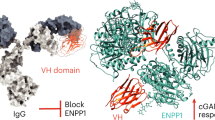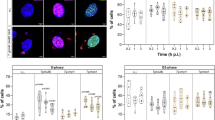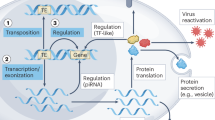Abstract
Customary binding sites of intron-encoded homing endonucleases lie within cognate intronless alleles, at the so-called homing sites. Here, we describe a novel, high-affinity binding site for I-TevI endonuclease, encoded within the group I td intron of phage T4. This site is an operator that overlaps the T4 late promoter, which drives I-TevI expression from within the td intron. I-TevI binds the operator and homing sites with equal affinity, and functions as a transcriptional autorepressor. Distinct sequence and spacing requirements of the catalytic domain result in reduced cleavage activity on operator DNA. Crystallographic studies showed that the overall interactions of the DNA-binding domain with the operator and homing sites are similar, but have some different hydrogen-bonding contacts. We present a model in which the flexibility in protein-DNA interactions allows I-TevI to bind variant intronless alleles to promote intron mobility while facilitating its function in autorepression, and thereby persistence in its host.
This is a preview of subscription content, access via your institution
Access options
Subscribe to this journal
Receive 12 print issues and online access
$259.00 per year
only $21.58 per issue
Buy this article
- Purchase on SpringerLink
- Instant access to full article PDF
Prices may be subject to local taxes which are calculated during checkout








Similar content being viewed by others
Accession codes
References
Belfort, M., Reaban, M.E., Coetzee, T. & Dalgaard, J.Z. Prokaryotic introns and inteins: a panoply of form and function. J. Bacteriol. 177, 3897–3903 (1995).
Gogarten, J.P., Senejani, A.G., Zhaxybayeva, O., Olendzenski, L. & Hilario, E. Inteins: structure, function, and evolution. Annu. Rev. Microbiol. 56, 263–287 (2002).
Belfort, M., Derbyshire, V., Cousineau, B. & Lambowitz, A. Mobile introns: pathways and proteins. In Mobile DNA II (eds. Craig, N., Craigie, R., Gellert, M. & Lambowitz, A.) 761–783 (ASM Press, Washington DC, 2002).
Dujon, B. et al. Mobile introns: definition of terms and recommended nomenclature. Gene 82, 115–118 (1989).
Mueller, J.E., Clyman, J., Huang, Y.-J., Parker, M.M. & Belfort, M. Intron mobility in phage T4 occurs in the context of recombination-dependent DNA replication by way of multiple pathways. Genes Dev. 10, 351–364 (1996).
Belfort, M. Bacteriophage introns: parasites within parasites? Trends Genet. 5, 209–213 (1989).
Galburt, E.A. & Stoddard, B.L. Catalytic mechanisms of restriction and homing endonucleases. Biochemistry 41, 13851–13860 (2002).
Jurica, M.S. & Stoddard, B.L. Homing endonucleases: structure, function and evolution. Cell. Mol. Life Sci. 55, 1304–1326 (1999).
Bryk, M. et al. The td intron endonuclease makes extensive sequence tolerant contacts across the minor groove of its DNA target. EMBO J. 12, 2141–2149 (1993).
Bryk, M., Belisle, M., Mueller, J.E. & Belfort, M. Selection of a remote cleavage site by I-TevI, the td intron-encoded endonuclease. J. Mol. Biol. 247, 197–210 (1995).
Chevalier, B.S. & Stoddard, B.L. Homing endonucleases: structural and functional insight into the catalysis of intron/intein mobility. Nucleic Acids Res. 29, 3757–3774 (2001).
Bechhofer, D.H., Hue, K.K. & Shub, D.A. An intron in the thymidylate synthase gene of Bacillus bacteriophage β22: Evidence for independent evolution of a gene, its group I intron, and the intron open reading frame. Proc. Natl. Acad. Sci. USA 91, 11669–11673 (1994).
Edgell, D.R. & Shub, D.A. Related homing endonucleases I-BmoI and I-TevI use different strategies to cleave homologous recognition sites. Proc. Natl. Acad. Sci. USA 98, 7898–7903 (2001).
Chu, F.K., Maley, G.F., Maley, F. & Belfort, M. Intervening sequence in the thymidylate synthase gene of bacteriophage T4. Proc. Natl. Acad. Sci. USA 81, 3049–3053 (1984).
Gott, J.M., Shub, D.A. & Belfort, M. Multiple self-splicing introns in bacteriophage T4: Evidence from autocatalytic GTP labeling of RNA in vitro. Cell 47, 81–87 (1986).
Young, P., Ohman, M., Xu, M.Q., Shub, D.A. & Sjoberg, B.-M. Intron-containing T4 bacteriophage gene sunY encodes an anaerobic ribonucleotide reductase. J. Biol. Chem. 269, 20229–20232 (1994).
Quirk, S.M., Bell-Pedersen, D. & Belfort, M. Intron mobility in the T-even phages: high frequency inheritance of group I introns promoted by intron open reading frames. Cell 56, 455–465 (1989).
Eddy, S.R. & Gold, L. The phage T4 nrdB intron: a deletion mutant of a version found in the wild. Genes Dev. 5, 1032–1041 (1991).
Gott, J.M. et al. Genes within genes: Independent expression of phage T4 intron open reading frames and the genes in which they reside. Genes Dev. 2, 1791–1799 (1988).
Semrad, K. & Schroeder, R. A ribosomal function is necessary for efficient splicing of the T4 phage thymidylate synthase intron in vivo. Genes Dev. 12, 1327–1337 (1998).
Van Roey, P., Waddling, C.A., Fox, K.M., Belfort, M. & Derbyshire, V. Intertwined structure of the DNA-binding domain of intron endonuclease I-TevI with its substrate. EMBO J. 20, 3631–3637 (2001).
Loizos, N., Silva, G.H. & Belfort, M. The intron-encoded endonuclease I-TevII binds across the minor groove and induces two distinct conformational changes in its DNA substrate. J. Mol. Biol. 255, 412–424 (1996).
Derbyshire, V., Kowalski, J.C., Dansereau, J.T., Hauer, C.R. & Belfort, M. Two-domain structure of the td intron-encoded endonuclease I-TevI correlates with the two-domain configuration of the homing site. J. Mol. Biol. 265, 494–506 (1997).
Dean, A.B. et al. Zinc finger as distance determinant in the flexible linker of intron endonuclease I-TevI. Proc. Natl. Acad. Sci. USA 99, 8554–8561 (2002).
Jeffery, C.J. Moonlighting proteins: old proteins learning new tricks. Trends Genet. 19, 415–417 (2003).
Belfort, M. Two for the price of one: a bifunctional intron-encoded DNA endonuclease-RNA maturase. Genes Dev. 17, 2860–2863 (2003).
Bolduc, J.M. et al. Structural and biochemical analyses of DNA and RNA binding by a bifunctional homing endonuclease and group I intron splicing factor. Genes Dev. 17, 2875–2888 (2003).
Miyake, T., Hiraishi, H., Sammoto, H. & Ono, B.-I. Involvement of the VDE homing endonuclease and rapamycin in regulation of the Saccharomyces cerevisiae GSH11 gene encoding the high affinity glutathione transporter. J. Biol. Chem. 278, 39632–39636 (2003).
Loizos, N., Tillier, E.R.M. & Belfort, M. Evolution of mobile group I introns: Recognition of intron sequences by an intron-encoded endonuclease. Proc. Natl. Acad. Sci. USA 91, 11983–11987 (1994).
George, J.W., Stohr, B.A., Tomso, D.J. & Kreuzer, K.N. The tight linkage between DNA replication and double-strand break repair in bacteriophage T4. Proc. Natl. Acad. Sci. USA 98, 8290–8297 (2001).
Belle, A., Landthaler, M. & Shub, D.A. Intronless homing: site-specific endonuclease SegF of bacteriophage T4 mediates localized marker exclusion analogous to homing endonucleases of group I introns. Genes Dev. 16, 351–362 (2002).
Edgell, D.R. Selfish DNA: new abode for homing endonucleases. Curr. Biol. 12, R276–R278 (2002).
Miller, E.S. et al. Bacteriophage T4 genome. Microbiol. Mol. Biol. Rev. 67, 86–156 (2003).
Van Roey, P., Meehan, L., Kowalski, J., Belfort, M. & Derbyshire, V. Catalytic domain structure and hypothesis for function of GIY-YIG intron endonuclease I-TevI. Nat. Struct. Biol. 9, 806–811 (2002).
Bell-Pedersen, D., Quirk, S.M., Bryk, M. & Belfort, M. I-TevI, the endonuclease encoded by the mobile td intron, recognizes binding and cleavage domains on its DNA target. Proc. Natl. Acad. Sci. USA 88, 7719–7723 (1991).
Jurica, M.S., Monnat, R.J. Jr. & Stoddard, B.L. DNA recognition and cleavage by the LAGLIDADG homing endonuclease I-CreI. Mol. Cell 2, 469–476 (1998).
Chevalier, B., Turmel, M., Lemieux, C., Monnat, R.J.J. & Stoddard, B.L. Flexible DNA target site recognition by divergent homing endonuclease isoschizomers I-CreI and I-MsoI. J. Mol. Biol. 329, 253–269 (2003).
Flick, K.E., Jurica, M.S., Monnat, R.J. Jr. & Stoddard, B.L. DNA binding and cleavage by the nuclear intron-encoded homing endonuclease I-PpoI. Nature 394, 96–101 (1998).
Lehman, I.R. & Pratt, E.A. On the structure of the glucosylated hydroxymethylcytosine nucleotides of coliphages T2, T4, and T6. J. Biol. Chem. 235, 3254–3259 (1960).
Newman, M., Strzelecka, T., Dorner, L.F., Schildkraut, I. & Aggarwal, A.K. Structure of BamHI endonuclease bound to DNA: partial folding and unfolding on DNA binding. Science 269, 656–663 (1995).
Viadiu, H. & Aggarwal, A.K. Structure of BamHI bound to nonspecific DNA: a model for DNA sliding. Mol. Cell 5, 889–895 (2000).
Belfort, M., Chandry, P.S. & Pedersen-Lane, J. Genetic delineation of functional components of the group I intron in the phage T4 td gene. Cold Spring Harb. Symp. Quant. Biol. 52, 181–192 (1987).
Depew, R.E., Snopek, T.J. & Cozzarelli, N.R. Characterization of a new class of deletions of the D region of the bacteriophage T4 genome. Virology 64, 144–145 (1975).
Shub, D.A. & Casna, N.J. Bacteriophage T4, a new vector for the expression of cloned genes. Gene 37, 31–36 (1985).
Heyduk, T. & Lee, J.C. Application of fluorescence energy transfer and polarization to monitor Escherichia coli cAMP receptor protein and lac promoter interaction. Proc. Natl. Acad. Sci. USA 87, 1744–1748 (1990).
Edgell, D.R., Stanger, M.J. & Belfort, M. Importance of a single base pair for discrimination between intron-containing and intronless alleles by endonuclease I-BmoI. Curr. Biol. 13, 973–978 (2003).
Brunger, A.T. et al. Crystallography & NMR system: A new software suite for macromolecular structure determination. Acta Crystallogr. D 54, 905–921 (1998).
Jones, T.A., Zou, J.Y., Cowan, S.W. & Kjeldgaard, M. Improved methods for building protein models in electron density maps and the location of errors in these models. Acta Crystallogr. A 47, 110–119 (1991).
Laskowski, R.A., McArthur, M.W., Moss, D.S. & Thornton, J.M. PROCHECK: a program to check the stereochemical quality of protein structures. J. Appl. Crystallogr. 26, 282–291 (1993).
Acknowledgements
We thank L. Conlan, J. Dansereau, and J. Pata for their thoughtful comments on the manuscript, J. Dansereau for figure refinements and M. Carl for expert manuscript preparation. This work was supported by US National Institutes of Health (NIH) grants GM39422 and GM44844 to M.B., GM56966 to P.V.R. and GM37746 to D.A.S. D.R.E. was supported by a postdoctoral fellowship from the Canadian Institute of Health Research. S.L. was supported in part by a stipend from the Center for Molecular Genetics, University at Albany. The X-ray diffraction facilities at beamline X12C of the National Synchrotron Light Source were supported by the US Department of Energy and by grants from the NIH. Oligonucleotides were provided by the Molecular Genetics Core Facility of Wadsworth Center.
Author information
Authors and Affiliations
Corresponding author
Ethics declarations
Competing interests
The authors declare no competing financial interests.
Rights and permissions
About this article
Cite this article
Edgell, D., Derbyshire, V., Roey, P. et al. Intron-encoded homing endonuclease I-TevI also functions as a transcriptional autorepressor. Nat Struct Mol Biol 11, 936–944 (2004). https://doi.org/10.1038/nsmb823
Received:
Accepted:
Published:
Issue date:
DOI: https://doi.org/10.1038/nsmb823
This article is cited by
-
Homing endonucleases from mobile group I introns: discovery to genome engineering
Mobile DNA (2014)
-
Post-transcriptional control by bacteriophage T4: mRNA decay and inhibition of translation initiation
Virology Journal (2010)
-
Mobile DNA elements in T4 and related phages
Virology Journal (2010)
-
Homing endonucleases: from basics to therapeutic applications
Cellular and Molecular Life Sciences (2010)
-
Energetics of the protein-DNA-water interaction
BMC Structural Biology (2007)



